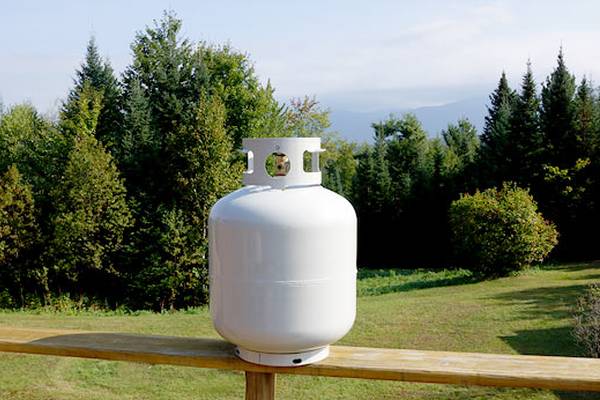
How Much Propane Does a 30 Lb Tank Hold? (How Many Gallons)
Nothing is as it seems. That is the case with propane. While the tank may have one level or capacity, the meters monitoring the actual fuel will say something else. There are legitimate reasons why this is so. Even though you are paying for a full tank, it may not be full.
The limit you can fill a 30-pound propane tank is 7 gallons. That makes the tank 80% full and leaves room for expansion. Propane is not like other fuels. It will expand on you, unlike gas or diesel where you can fill the tank to the brim and have no problems.
To learn more about this topic, just continue to read our article. It provides the best information possible so you can handle your propane tanks safely and not get angry when you are paying full price for 80% capacity.
How Much Propane is in a 30 lb Tank?

When you have an empty propane tank, it should weigh between 25 to 28 pounds. This is important information as many propane dealers go by weight rather than gallons when filling your tank.
The average gallon of propane weighs roughly 4.125 pounds and that times 7 equals almost 29 pounds. While the tank may weigh over 50 pounds when full, you are only paying for the weight of the propane which is almost 30 pounds.
You are getting almost 30 pounds of propane inside a 30-pound propane tank but that does not mean the tank is full. Without room for expansion, the tank should hold 8 3/4 gallons.
You never want to fill a propane tank until it is truly filled. You will have problems and an explosion may occur if you do. The over-flow valve should prevent this situation from taking place.
How Many Gallons Of Propane is in a 30 lb Tank?

When you start seeing the propane sputter out of the overflow valve, you should be at 7 gallons, give or take a small portion of a gallon. You only fill the propane tank to 80% of capacity as propane does expand.
In fact, when propane expands it produces 17% more volume than water does when it expands. The source of the expansion is heat and in some cases, you cannot avoid the heat when you camp in those warmer southern states.
If you fill the propane tank to its actual capacity, the propane has nowhere to expand and an explosion may occur. Propane is very volatile and needs to be handled with care.
Federal regulations state that you have to use an over-pressure device when filling your tank to make sure you stop at 80%.
How Much Pressure is in a 30 lb Propane Tank?

You may not think so but propane is under a lot of pressure when put inside your propane tank. That pressure depends on the ambient temperature in the state you are currently in.
For example, a propane tank in 70-degree heat will have the propane at 145 psi. This is well below the standard psi which is set at 200. Anything greater than 200 is not good.
The same tank at 100 degrees will be at 172 psi. These figures are for a 20-pound propane tank which has been the only example we have found so far. But the standard levels are the same.
You want to keep your propane tanks under 200 psi and temperatures over 105 will boost their psi to 235. The good news is if your propane tank has a pressure relief valve attached, it will open up at those high levels and release some of the pressure keeping you and your family safe.
How Much Does a 30-Pound Propane Tank Weigh Empty?

As usual, we have jumped the gun and already stated what the empty weight of a propane tank is. You are looking at [picking up between 25 and 28 pounds. The weight may differ due to who made it and what materials were used.
Do not worry, you are not paying for that empty weight. That is used as the Tare weight to help monitor how much propane actually goes into your tank. The tare weight is set to ‘0’ when you place it on the scale so you and the attendant know exactly how much propane is inside the tank.
Then you are charged accordingly. The drawback to this system is that you do not know if the scales are accurate or have been altered in some way. If the latter is true, then you are paying more or less than the actual cost of the propane in your tank.
How Many BTU in a 30 lb Propane Tank?

One gallon of propane is rated at 92,000 BTUs. What that means is if your furnace is rated for 30,000 BTUs, one gallon of propane should last you 3 hours.
However, since a furnace does not run at full volume for 180 minutes, your one gallon of propane can last 24 hours. With 7 gallons inside your 30-pound propane tank should have 574,000 BTUs approx.
That is a lot of fuel for your 30,000 BTU furnace to use up. If you multiply the 24 hours by 7, then you get 168 hours of propane use under normal circumstances. That works out to be one week’s worth of fuel under normal circumstances.
Figures will differ depending on the model furnace and other propane-fueled appliances you have inside your RV or trailer. The above are examples only.
Some Final Words
30-pound propane tanks provide a lot of fuel for your propane appliances. If you have 2 of these you may be able to go more than a week without refilling the tanks.
The key is to never cross that 80% threshold when you fill up those tanks and make sure you have a pressure release and over-fill device on the tanks. Stay safe.

